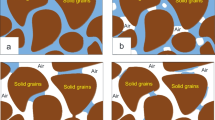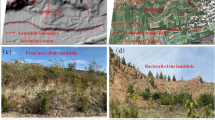Abstract
Stress reduction factor, λ, is a dimensionless coefficient in two-dimensional (2D) analysis based on convergence confinement method (CCM) of tunnel which represents stress relaxation in the tunnel walls at different excavation steps. The aim of this paper is to look into the influencing factors on parameter λ around the tunnel walls using finite difference code in order to improve the accuracy of the CCM. For this purpose, four different ground types with various tunnel radii, depths and cross section shapes are considered. Finally, the 2D analysis using uniform and variable stress reduction factors determined in this paper is compared with the 3D analysis of the tunnel. The results of this study enhance our understanding of the role of geometrical and soil material parameters of tunnel on stress relaxation around tunnel walls. The tunnel depth, soil type and tunnel shape have great influence on λ. Variable stress reduction factor enables the convergence–confinement method to predict the realistic behavior of third dimension of the tunnel and can also be used as the best alternative to 3D models.
















Similar content being viewed by others
References
Addenbrooke T, Potts D (2001) Twin tunnel interaction: surface and subsurface effects. Int J Geomech 1(2):249–271
Amberg F (2011) For a correct interpretation of ground reaction curves. In: 12th ISRM Congress, International society for rock mechanics
Attewell P (1977) Ground movements caused by tunnelling in soil. In: Conference on Large Ground Movements and Structures, Cardiff, p 812–848
Atzl GV, Mayr JK (1994) FEM analysis of Heathrow NATM trial tunnel. In: Numerical methods in geotechnical engineering. Balkema, Rotterdam, pp 195–201
Bernat S, Cambou B (1998) Soil-structure interaction in shield tunnelling in soft soil. Comput Geotech 22(3):221–242
Bernaud D, Rousset G (1996) The ‘new implicit method’for tunnel analysis. Int J Numer Anal Meth Geomech 20(9):673–690
Bloodworth A (2002) Three-dimensional analysis of tunneling effects on structures to develop design methods. Oxford University, UK
Bouvard-Lecoanet A, Colombet G, Esteulle F (1988) Ouvrages souterrains-Conception, réalisation, entretien, 2nd ed. Presses de L'Ecole Nationale des Ponts et Chaussees, Paris, p 286
Brown ET et al (1983) Ground response curves for rock tunnels. J Geotech Eng 109(1):15–39
Burd H et al (2000) Modelling tunnelling-induced settlement of masonry buildings. Proc Inst. Civ. Eng.Geotech Eng 143(1):17–30
Cairncross A (1973) Deformations around model tunnels in stiff clay in engineering department. Cambridge University, UK
Carranza-Torres C, Fairhurst C (2000) Application of the convergence–confinement method of tunnel design to rock masses that satisfy the Hoek-Brown failure criterion. Tunn Undergr Space Technol 15(2):187–213
Chen R-P et al (2013) Experimental study on face instability of shield tunnel in sand. Tunn Undergr Space Technol 33:12–21
Corbetta F Bernaud D, Nguyen Minh D (1991) Contribution à la méthode convergence-confinement par le principe de la similitude. Revue Française de Géotechnique 54, pp 5–12
Fairhurst C, Carranza-Torres C (2002) Closing the circle. In: Proceedings of the 50th annual geotechnical engineering conference
González-Nicieza C et al (2008) Influence of the depth and shape of a tunnel in the application of the convergence–confinement method. Tunn Undergr Space Technol 23(1):25–37
Graziani A, Boldini D, Ribacchi R (2005) Practical estimate of deformations and stress relief factors for deep tunnels supported by shotcrete. Rock Mech Rock Eng 38(5):345–372
Heidari M, Tonon F (2015) Ground reaction curve for tunnels with jet grouting umbrellas considering jet grouting hardening. Int J Rock Mech Min Sci 76:200–208
Higgins K et al. (1996) Numerical modelling of the influence of the Westminster Station excavation and tunnelling on the Big Ben clock tower. In: Proc. Int. Symp. on geotechnical aspects of underground construction in soft ground, preprint vol., London
Hoek E, Brown ET (1980) Undeground excavations in rocks. Institution of Mining and metarllurgy, E & FN SPON
Itasca F (2002) Fast lagrangian analysis of continua, version 4.0 user’s guide. Itasca Consulting Group. Inc., Thrasher Square East, Minneapolis, p 708
Karakus M (2007) Appraising the methods accounting for 3D tunnelling effects in 2D plane strain FE analysis. Tunn Undergr Space Technol 22(1):47–56
Lee K, Rowe R (1991) An analysis of three-dimensional ground movements: the Thunder Bay tunnel. Can Geotech J 28(1):25–41
Lee K, Rowe RK, Lo K (1992) Subsidence owing to tunnelling. I. Estimating the gap parameter. Can Geotech J 29(6):929–940
Lombardi G (1973) Dimensioning of tunnel linings with regard to constructional procedure. Tunnel and tunneling, No. 4, pp 340–351
Mair R, Taylor R, Bracegirdle A (1993) Subsurface settlement profiles above tunnels in clays. Geotechnique 43(2):315–320
Meguid M et al (2008) Physical modeling of tunnels in soft ground: a review. Tunn Undergr Space Technol 23(2):185–198
Mitaim S, Detournay E (2005) Determination of ground reaction curve for hyperbolic soil model using the hodograph method. Can Geotech J 42(3):964–968
Ng CW, Lee GT (2005) Three-dimensional ground settlements and stress-transfer mechanisms due to open-face tunnelling. Can Geotech J 42(4):1015–1029
Ng CWW, Simons CN, Menzies B (2004) A short course in soil-structure engineering of deep foundations, excavations and tunnels. Thomas Telford Services Limited, London
Oreste P (2003) Analysis of structural interaction in tunnels using the covergence–confinement approach. Tunn Undergr Space Technol 18(4):347–363
Orr T (1976) The behavior of lined and unlined model tunnel in stiff clay, in engineering. Cambridge University, UK
O’ReiIIy M, New B (1982) Settlements above tunnels in the UK—their magnitude and prediction. In: Proceedings of Tunnelling’82, London, p 173–181
Panet M, Guenot A (1982) Analysis of convergence behind the face of a tunnel: Tunnelling 82. In: proceedings of the 3rd international symposium, Brighton, 7–11 June, p 197–204. Publ London: IMM, . in International Journal of Rock Mechanics and Mining Sciences and Geomechanics Abstracts. 1983. Pergamon
Panet M (1995) Le calcule des tunnels par la methode convergence-confinement. Presses ENPC, Paris
Peila D, Oreste P (1995) Axisymmetric analysis of ground reinforcing in tunnelling design. Comput Geotech 17(2):253–274
Potts D (1977) Behavior of lined and unlined tunnels in sand, in engineering department. Cambridge University, UK
Potts DM, Zdravkovic L (2001) Finite element analysis in geotechnical engineering: application, vol 2. Thomas Telford, London, p 427
Rowe R, Lo K, Kack G (1983) A method of estimating surface settlement above tunnels constructed in soft ground. Can Geotech J 20(1):11–22
Sadeghiyan R, Hashemi M, Moloudi E (2016) Determination of longitudinal convergence profile considering effect of soil strength parameters. Int J Rock Mech Min Sci 82:10–21
Schikora K, Ostermeier B (1988) Two-dimensional calculation model in tunneling-verification by measurement results and by spatial calculation. In: Sixth international conference on numerical methods in geomechanics, Innsbruck, Austria
Schmidt B (1974) Prediction of settlements due to tunneling in soil: three case histories. In: Proceedings of the second rapid excavation and tunneling conference, San Francisco, p 1179–1199
Shin J (2000) Numerical analysis of tunnelling in decomposed granite soil. Imperial College London (University of London), London
Swoboda G, Marence M, Mader I (1994) Finite element modelling of tunnel excavation. Int J Eng Model 6:51–63
Swoboda G (1979) Finite element analysis of the new austrian tunnelling method (NATM). In: Proceedings of the 3rd international conference on numerical methods in geomechanics, Aachen
Vlachopoulos N, Diederichs MS (2014) Appropriate uses and practical limitations of 2D numerical analysis of tunnels and tunnel support response. Geotech Geol Eng 32(2):469–488
Wong R, Kaiser P (1991) Performance assessment of tunnels in cohesionless soils. J Geotech Eng 117(12):1880–1901
Author information
Authors and Affiliations
Corresponding author
Rights and permissions
About this article
Cite this article
Mousivand, M., Maleki, M., Nekooei, M. et al. Application of Convergence–Confinement Method in Analysis of Shallow Non-circular Tunnels. Geotech Geol Eng 35, 1185–1198 (2017). https://doi.org/10.1007/s10706-017-0173-4
Received:
Accepted:
Published:
Issue Date:
DOI: https://doi.org/10.1007/s10706-017-0173-4




